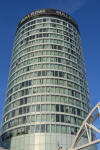Round The World and other travels
A frequent flyer's collection of trip diaries
March 2016: Birmingham
Birmingham, in the West Midlands, is the United Kingdom's largest city outside London. (But as I found out on another visit just days prior to this one, Manchester, rather than Birmingham, is at the heart of the country's second-largest conurbation.) Once a medium-sized market town, Birmingham owes its growth and emergence as a major city to the Industrial Revolution. When traditional heavy industries subsequently began to decline in the western world, Birmingham managed to remain prosperous for longer than many other similarly affected places, but it then went on to suffer major decline in the final two decades of the 20th century. I passed through the city on a few occasions during this period and I was not impressed by what I saw.
In a repeat of a story that I have seen unfold in many urban centres both at home and across the globe, however, massive regeneration efforts in the new century are now visibly bearing fruit. In addition to completed new developments, a lot of construction was ongoing in the city centre during my visit. This work included the tram-based Midland Metro system, which was in the course of being gradually extended onto the streets of Birmingham city centre.
I left the city on this occasion with an entirely different perception from those earlier brushes with the place, and even with a wish to return to see the outcome of all the work that was still in progress.
Westside canals
My hotel formed part of Brindleyplace, a mixed-use development of offices and leisure facilities brought about by a canal-side regeneration project in Birmingham's Westside. Most prominent among the buildings is the Ikon Gallery, which showcases contemporary art in a converted Victorian boarding school. Unfortunately it was closed on the day my visit - a Monday.
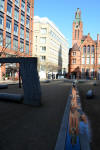 |
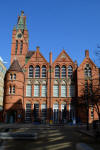 |
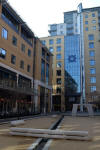 |
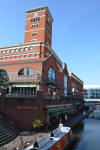 |
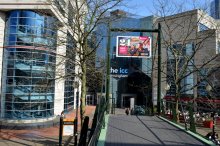 |
Gas Street Basin is a busy and consequently colourful mooring facility for canal boats, situated south of Brindleyplace.
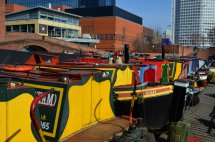 |
 |
 |
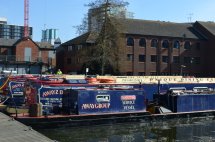 |
 |
|||
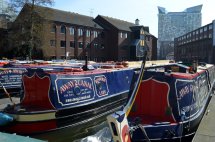 |
 |
 |
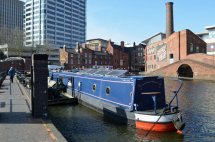 |
 |
 |
A little further south again is the Mailbox, a shopping and office development that includes the studios of BBC Birmingham.
 |
 |
 |
 |
 |
 |
Centenary Square
Centenary Square lies on Broad Street, directly east of the Brindleyplace development. It is home to the International Convention Centre, Symphony Hall, the Birmingham Repertory Theatre, the Library of Birmingham, Baskerville House and the Hall of Memory. The strikingly modern library building is particularly notable and has been claimed to be the greatest public information resource in Europe - presumably after the Internet. The square's open space regularly hosts events as diverse as a Christmas market and the city's Remembrance Day service.
 |
 |
 |
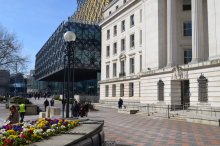 |
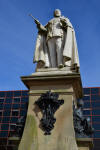 |
 |
 |
 |
Victoria Square
Victoria Square is considered to be the true centre of Birmingham, with distances to and from the city measured from there. Birmingham has both a Town Hall and a Council House, the former being a concert venue and the latter the seat of local government, and they are to be found in this location.
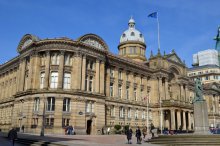 |
 |
 |
 |
 |
 |
 |
 |
 |
Birmingham Cathedral
Dating from the 18th century and dedicated to St Philip, Birmingham Cathedral started life as a parish church. It was elevated to the rank of cathedral in 1905 when the Church of England created a new diocese based in the city. It is one of the smallest cathedrals in England, but an attractive one that offered a particularly friendly welcome to visitors.
 |
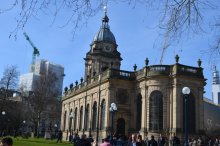 |
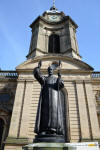 |
 |
 |
 |
 |
Birmingham Museum and Art Gallery
Prior to my visit to the city, I had seen several short television features making me realise that Birmingham had a highly rated museum and art gallery. I was therefore pleased to be able to sample it in person.
 |
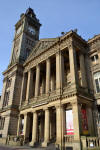 |
 |
 |
 |
 |
 |
 |
 |
 |
 |
Bullring and Grand Central
Two large and modern shopping centres adjoin Birmingham's New Street Station. The Bullring dates from 2003 and clearly takes its name from the immediate neighbourhood, known as the Bull Ring. Grand Central (2015) replaced a 1971 development and was opened alongside the newly modernised railway station.
Base: Novotel Centre
Linked report from same trip:






